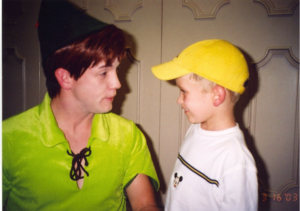The Disney World attendant reached out her hand toward my crying son and said, “Russell… will you come with me please?” Earlier we had asked about getting Peter Pan’s autograph and we were told he would not be signing autographs today, but he would be in the parade down Main Street USA. Peter Pan was on top of the very last parade float and was waving to the crowd. When my son saw he was not going to stop and sign his autograph book extended from his 4-year-old arms, he began to cry.

It’s no secret that we all connect with stories. Well-told stories tell us so much about people, life, and morals. Professional speakers know this truth and they use stories regularly to engage their audiences. In business, the best presenters know this also and they bring their data to life by allowing the data to tell a story. This is probably nothing new to you. But… there is one aspect of storytelling that can create the greatest impact with your audience. This element is probably something you’ve always loved but never consciously noticed.
The Secret: All the best stories include dialogue
Dialogue can be just one simple line or phrase from the story spoken just like it was originally spoken when the story actually took place. The speaker actually becomes that character for a brief moment and acts out what that line of dialogue sounded like to their own ears. Why is this so engaging? There are four main reasons:
1. Dialogue puts action in the story
It is happening right now! When you hear that one line of dialogue, you are no longer talking about something that happened in the past. To the audience, it looks like it is happening right now! The dialogue progresses the story and shows an active participant.
2. Dialogue engages the brain
For the brain to comprehend the past in a present tense, it actually has to transport your mind through time to the exact moment when the dialogue took place. As odd as it sounds, your audience is time traveling with you back to that moment. This creative process engages their brains! The creative side of their brains has to build a vision of the scene and the characters speaking those exact words.
3. Engagement equals an attentive audience
I’m sure you have seen some engaging speakers and some who are not so engaging. When we observe an engaging speaker we need to ask ourselves, “What specifically made me say she was engaging?” One answer to that question may be the speaker’s proper use of dialogue that forced your brain to build a movie set and travel through time. Brain engagement means audience engagement, which means audience attention!
4. Vivid imaginations produce feelings
Well-told stories with dialogue not only engage our brains creatively, but then they tap into our emotions. Speakers know that feelings are necessary to provide the motivation and fuel for the audience to take the next step. Without the feeling of motivation, the audience will not be willing to do whatever you’re asking them to do next.
Back to our story…
The Disney World attendant led my son through City Hall to a large wooden door. As she opened it and invited us both into the room, Peter Pan himself was standing there to greet us. Then Peter Pan exclaimed, “Russell! There you are, buddy! I’ve been looking for you all day.”
How does dialogue in a story affect you? When have you seen a speaker use dialogue well?
Always looking for my next step to improve,
Russ
P.S. The Disney story I shared above is very real. I’ve been a huge fan, proponent, and passionate advocate for Disney ever since. Here’s a picture of that moment. Russell was 4 yrs old.
p.p.s. If you like these blog posts, please don’t keep it a secret. Your shares, likes, and forwards are always appreciated! THANK YOU for being connected with me. Until next time…



Please note: I reserve the right to delete comments that are offensive or off-topic.